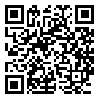BibTeX | RIS | EndNote | Medlars | ProCite | Reference Manager | RefWorks
Send citation to:
URL: http://jdm.tums.ac.ir/article-1-366-en.html
Statement of Problem: There are different tooth brushing methods for removing dental plaque from tooth surfaces. The effectiveness of these methods, and the time needed for instruction, learning and using seem to be different. Also, it is possible that the effectiveness of each method reduces with time, based on its difficulty level and the reduction of the patient s attention in following the given instructions. Purpose: The aim of this research was to compare the effectiveness of six different accepted tooth brushing methods on total and specific teeth, as well as on special tooth surfaces. The research also compared the time needed for instruction, learning and using the methods. Materials and Methods: The study was designed as a single blind randomised controlled trial protocol to compare the six accepted tooth brushing methods: Roll, Bass, Charters (C), Modified Stillman (MS), and Modified Bass in two ways (MB1-MB2). 15 volunteers were selected from the basic science level dental students at Tehran University of Medical Sciences. All the six methods were instructed to each volunteer, using a randomly selected sequence. Each participant should, therefore, pass six consequent courses, by the same sequences as follow: 1st Visit: After polishing the teeth, the participant was asked to abstain any kind of tooth cleaning. - 2nd visit (48-72 hours later): O Leary Plaque Index (PI) was recorded and then the randomised selected method was instructed. Then, the participant brushed his/her teeth and PI was registered again. The time needed for instruction and using the method was registered too. The participant was then asked to use this newly learned tooth brushing method twice a day for 7±1 days. - 3rd visit (7±1 days later): PI was recorded. The teeth were polished. The participant was asked to abstain any kind of tooth cleaning for 48-72 hours, as washout period of the previous method and preparation period for the next method (2nd visit of the next course). The final stage was comparing the results, in which the effectiveness of each method was evaluated based on the mean percentage of plaque reduction after the first usage, and also the mean percentage of the plaque remained after using the method for 7±1 days. The time needed for instruction, learning and using the methods were also compared. The statistical analysis was done using the SPSS software and variance analysis (randomised block design).
Results: Considering all the teeth and their total surfaces after 1st usage, the methods of C and MB1 were statistically more effective than the other methods. But the difference between these two methods was not significant. Also after 7±1 days, the differences between all methods were not statistically significant. On the posterior teeth, after 1st usage and also after 7±1 days, the method of C was significantly more effective than the others, with the exception of MB1 for which their differences were not significant. Also MB1 was significantly more effective than the methods of Bass and Roll, but only after the 1st usage. On the anterior teeth, after 1st usage, method of C was statistically more effective than the methods of Bass, MB2 and MS. Also MB1 was significantly more effective than MB2 and MS. But after 7±1 days, the differences proved insignificant. Considering the specific surfaces of the teeth on the proximal surfaces, after the 1st usage of the methods, the methods of C and MB1was significantly more effective than the others, except each other, which their difference was not significant. But after 7±1days the method of C was statistically more effective only than the methods of Bass, MB2 and MS, and the method of MB1was significantly more effective than MB2. On the buccal and lingual surfaces the differences were not statistically significant at both stage of evaluation. When statistically considering the time needed for instruction, learning and usage, the method of C needed more time than Bass and Roll methods. In the same way, MB1 needed more time than Roll method. The most time needed was related to MB2 which was more than the time needed for the methods of Bass, Roll and MS (P<0.001 and α=0.05).
Conclusion: The tooth brushing methods of Charters’ and a kind of Modified Bass method (in which Bass and Roll methods are used separately and consequently) were evaluated as the most effective methods.
| Rights and Permissions | |
 |
This work is licensed under a Creative Commons Attribution-NonCommercial 4.0 International License. |




